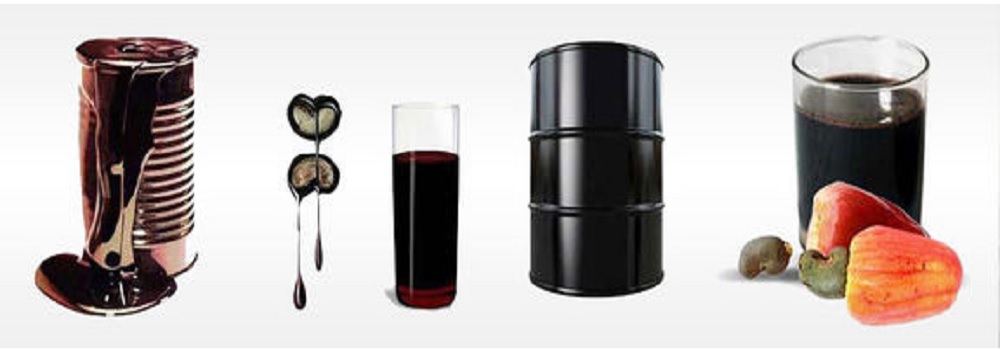
Cashew Nutshell liquid and its derivatives in oil field applications.
The oil and gas industry is often challenged with serious problems like high cost of oil field chemicals and environmental toxicity issues of commonly used synthetic oil field chemicals, and this has dragged the attention of researchers to the search for more cost effective and environmentally friendly oil field chemicals. Oil field chemicals formulated from various renewable sources (such as plant extracts) have been recognized as an alternative with great environmental advantages, cost advantage, and availability compared to their synthetic counterparts. Cashew nut shell liquid (CNSL), a byproduct of the cashew industry, stands out as a unique renewable starting material amongst others due to its peculiar structural feature, low cost, and availability. It consists of naturally occurring substituted phenolic compounds that can participate in diverse reactions for the manufacture of numerous useful products. A large number of chemicals and products have been developed starting from CNSL by taking advantage of the reactive sites namely phenolic hydroxyl, aromatic ring, the acid functionality, and unsaturation(s) in the C15 alkyl side chain. This update gives highlights on the composition, extraction, isolation, and reactivity of CNSL. It also focuses on the oil field application of CNSL and its derivatives.
Cashew Nut Shell Liquid as compression-ignition engine fuel (Biofuel/Biodiesel)..
Cashew Nut Shell Liquid (CNSL) being used as an alternative fuel for diesel engine. The viscosity of CNSL is 30 - 35 times higher than diesel; hence different blends of CNSL would have different properties and application. Also, modification of the oil and its application condition such as, injection pressure, injection timing and preheating the oil also optimizes the performance of the engine. There were indications that preheating of CNSL25 blends at 200 kg/cm2 injection pressure and 28° injection timing gives encouraging results suitable for commercial purposes . CNSL as a bioadditive in engines increases the durability of the equipment. Hence, the application of CNSL as a bioadditive will reduce the dependency on petroleum products besides preserving the environment by lowering pollutant residues from fuel combustion products. Some of the properties of diesel, biofuel and ethanol are presented against CNSL . CNSL has higher density than diesel. It can be reduced by degumming and trans esterification. Cetane for CNSL is expected to be poor due to the presence of aromatic compounds. The usual C:H:O ratio for vegetable oils is 78:12:10 whereas for CNSL it is 80:12:8; hence, it justifies the higher calorific value of CNSL (47 MJ/kg), whereas for diesel it is 42 MJ/kg. Also, ash content is well within the limits for CNSL. The water content of CNSL is quite high. The sulphur content does not exceed 0.006% for any vegetable oil. Thus it is anticipated that CNSL has no sulphur content. The flash point for CNSL is 164°C; this is higher than the flash point for diesel and represents the higher starting ignition temperatures and compression of CNSL.
Cashew Nut Shell Liquid as a replacement of furnace oil and Light Diesel Oil ( LDO)
Light Diesel oil (LDO) and furnace oil mainly belong to the intermediate boiling range products of crude oil distillation. As a result, LDO and furnace oil have a high metallic content along with other impurities which is detrimental to our daily usage and additionally the petroleum reserves are stiffly exhausting. Prices of petrochemical derivatives are rising. So, an urgent replacement is needed in order to maintain the stability of our economy.
In an experiment, the properties of both LDO, furnace oil and CNSL were tested and the results were compared. According to obtained results, CNSL was found to have a higher ash content as compared to both LDP and furnace oil, but that is only more by 1%. So, this little amount of difference can be tolerated in our industrial heating applications. The Gross Calorific Value (GCV) and relative density of the LDO, furnace oil and CNSL are the same. Moisture content is same for CNSL and furnace oil but is lower for LDO. So, the moisture of CNSL needs to be removed to some extent before being used in replacement of LDO. The moisture content can easily be removed.
The most notable point of difference is that the flash point for CNSL (170°C) is much higher than that for LDO (66°C) and furnace oil(66°C). The pour point of CNSL (2°C for both summer and winter) is much lower than LDO (120 °C for winter and 20 °C in summer). The comparatively higher flash point and lower pour point indicate that the CNSL in much safer to use and will be much more commercial if used in place of LDO and furnace oil.